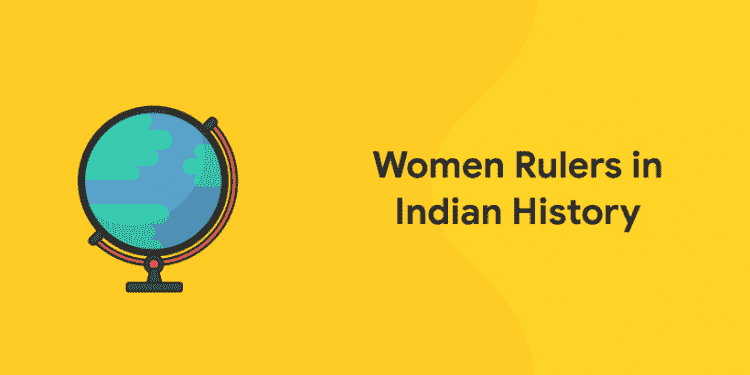Table of Contents
At times, when we wander through the pages of Indian History, we tend to come across a common fact where the male dominance in the society is visible. However, this does not mean that Indian women were not in the forefront during the years before the colonization and the struggle for independence. There are numerous instances in the history of India where the resilience and bravery of Women Rulers as well as Women Fighters serve as the base of India’s story of Women Empowerment. These stories ought to be remembered, re-told and shared widely amongst the people of today. Therefore, in this article, let us read and understand about the famous Women Rulers in the History of India.
Women Rulers in the History of India
The Indian History is so rich and diverse in nature. Most of the time, all that we hear are the stories of great men who fought for their land and achieved greatness. However, there are many names of Women Rulers in the History of India that are mostly forgotten. Here, let us take a moment and remember the brave and courageous women rulers who left a mark of their own in the Indian history. At a time when most women were not even allowed to move out of their houses, these fierce women ruled and protected their kingdoms.
Although we do not really hold the complete record of women rulers in the Indian history, we definitely shall list some of the most important ones here. One thing common about all the women rulers in the history of India is that they fought hard, very hard, to be able to challenge the patriarchal values which existed back then. Hence, they have become the role models to today’s women with their strength, confidence and pliability.
Ace your Exam preparation with Entri! Download Now!
List of Women Rulers in the History of India
1: Who was the first woman President of India?
Before independence, India was composed of tiny kingdoms who usually fought against each other for power and superiority. Thus, when we examine the history of the Indian Subcontinent, we definitely come across a number of rulers who ruled various kingdoms at different time periods. Among these rulers, there are a few Women Rulers also, whose names will be forever encrypted in history. Because, during a time when women were nowhere found to be empowered, those women rulers were brave enough to fight against all the odds.
These women rulers are still an inspiration to all the growing young girls to fight for what is right.
- Razia Sultan
- Rani Lakshmi Bhai
- Ahilya Bai Holkar
- Rani Chennamma
- Rani Mangammal
- Maharani Durgavati
- Chand Bibi
- Rani Avantibai
- Begum Samru
- Rani Rudramma
Razia Sultan
As brave a woman she was, Razia did not let her be addressed as ”Sultana”. The word Sultana meant Sultan’s Wife, which she didn’t feel was the right usage. She insisted on being called Razia Sultan. Indeed, one of the most noteworthy Delhi Sultans, Razia was one such courageous and just ruler who was loved by all.
Razia Sultan was the daughter of Shamsuddin Iltutmish who ruled Delhi in 1211 A.D. Out of all his children, the Sultan found none of them worthy to become his successor except Razia. This came as a blow to his sons who were expecting to be crowned as the next Sultan. After the death of Shamsuddin Iltutmish, a group of people did not accept Razai as the next Sultan. The reason that they cited was her being a woman. Therefore, Ruknuddin Firuz, son of Iltutmish was crowned as the new ruler. However, he proved to be a terrible ruler and people began to wail to bring Razia into power. And finally, when Razia was crowned the Sultan of Delhi in 1231 A.D, she proved them all right by her excellence.
She was the first female ruler in medieval India and the first woman ruler of the Delhi Sultanate.The legacy of Razia Sultan remains in the hearts of people till date, showing us what a true ruler she was!
Rani Lakshmi Bhai (1835 – 1858 A.D)
The life story of Rani Lakshmi Bhai, the Queen of Jhansi has not been a fairy tale. She was a true warrior who never gave up.
Born as Manikarnika Tambe (Manu) on November 19, 1828 to a Marathi family, her whole life is event-filled. Her parents were Moropant Tambe and Bhagirathi Sapre. She was educated to read and write. Moreover, she had excellent skills in shooting, malkamb, fencing, etc.
When Rani Lakshmi married Gangadhar Rao Newalkar , the Maharaja of Jhansi, as per the tradition, she was given the title Maharani Lakshmi Bhai. Later, she gave birth to her son Damodar Rao in 1851. Unfortunately, four months after birth, the child passed away. Later on the couple adopted a baby and renamed him Damodhar Rao.
Unfortunately, after the death of Gangadhar Rao his son was not allowed to succeed the throne as he was an adopted prodigy. Consequently, the British asked Rani Lakshmi Bhai to leave the palace. This eventually brought out the warrior inside the Jhansi Rani. She began to battle for her motherland along with other allies against the British.
Rani Lakshmi Bhai was wounded during a battle against British at Gwalior in 1858 which turned out to be the reason for her death. Today, even 175 years after her death, Rani Lakshmi Bhai, popularly called as Jhansi Rani is a hero for many young girls out there.
Ahilya Bai Holkar (1725 – 1795 A.D)
Born as the daughter of Manakoji Shinde, Ahilya Bhai Holkar ruled Ahmednagar from 1766 to 1795. She was married to Khande Rao who later died in the battle of Kumbher in the year 1764. Eventually, her father-in -law guided her towards the throne and she went on to become one of the most efficient rulers of all times.
The reigning period of Ahilya Bai Holker was said to be peace filled. She was a woman of great administrational skills who had a passion for art and literature. The lives of people flourished under her rule. She made it a point to be Dharamshalas in every nook and corner of the kingdom, thereby ensuring the wellness of all types of people.
Click here for GK notes on various topics!
Rani Chennamma (1778 – 1829 A.D)
Rani Chennamma was married to the ruler of Karnataka, Somesekara Nayak. She later on went to show her interest in politics and administration. When the King died of illness, Rani Chennamma took over the throne and ruled the kingdom. Rani Chennamma was fearless and fierce. She even fought against Mughal Emperor Aurangezeb who went on to call her as “Female Bear”,
Rani Mangammal (1689-1706 A.D.)
One of the prominent names to remember when talking about women rulers in the Indian History is the name of Rani Mangammal. According to the century old tradition followed by the Nayaka Kingdom of Mathura, women were not allowed to rule the kingdom. However, the reign of Rani Mangammal was an exception.
Rani Mangammal is often called by prominent historians as a ‘Visionary Queen’. Years after her reigning period, she is avidly remembered for her interest in the welfare of her subjects. She often tried to resolve problems with foes not with wars or battles but with treaties of peaceful means. She took keen interest in building roads throughout the kingdom. Back then, she built a highway connecting Madurai to Kanyakumari which is even now called as “Mangammal Salai”.
Even though many facts about the life of Rani Mangammal are known to us, details regarding her death are still a mystery. To sum up, it would be unfair to speak of the history of Mathura without mentioning Rani Mangammal’s name. The rich heritage that her reign left us with is still glowing, even after centuries.
Maharani Durgavati
Born into the family of Chandel Rajputs, Maharani durgavati ruled Gondwana from 1550 until 1564. After the death of her husband Dalpat Shah, he ruled the kingdom on behalf of theri son. Her ruling period is known to be prosperous and peaceful. This lured the Mughals and they planned an invasion of her kingdom. The Mughals fiercely attacked Gondwana in 1564. However, the battle soon was overpowered by the Mughals. Hence Maharani Durgavati killed herself by choosing death over defeat by the enemies. Her martyrdom day , 24th June is even today remembered as. “Balidan Diwas”.
Attempt a free mock test to boost your GK! Click here!
Chand Bibi (1550 – 1599 A.D.)
Chand Bibi was born as the daughter of Hussain Nizam Shah I of Ahmednagar. She was married to Sultan Adil Shah who ruled Bijapur, In an unfortunate incident, the own men of the Sultan murdered him. Thereupon she acted as the regent of the Sultanate of Bijapur as well as the Sultanate of Ahmednagar.When the Mughals attacked the kingdom in 1595, she led her army to successfully defend the kingdom. People called her Chand Khatun or Chand Sultana out of love and respect for her.
Her death is another sad story of misunderstanding by her own men. She was killed by her people itself in the year 1599.
Rani Avantibai (1858 A.D.)
Avantibhai Lodhi was born into the Lodhi Rajput family in the year 1831. She was married to the ruler of Ramgarh, Vikramaditya Singh Lodhi. During his reign, Rani Avantibai efficiently managed the state affairs. When the king suddenly died leaving behind only a minor heir, Rani Avanti Bai took charge of the kingdom. The measures that she took for the welfare of the people raised her popularity amongst the people. It is believed that she directed the farmers to not follow the rules set by the British.
Rani Avanti Bai resorted to suicide to end her life, when her army was on the verge of defeat during a war with the British on 20th March, 1858.
Begum Samru
Begum Samru was born in the year 1753. With her exceptional leadership skills, she went on to rule the State of Sardhana ?(now Meerut) for a long span of 55 years. Many times she helped the Mughal Army of Shah Alam. Eventually, he gave her the title “Zebunnissa” which meant ornament among women.
In the entire Indian History, Begum Samru is the only ruler of Catholic origin who ever ruled India. She died on 27th January 1837 at Sardhana.
Rani Rudramma (1259 – 1289 A.D.)
Rudramma Devi was the ruler of Kakateya Dynasty of the Deccan Plateau from 1263-1289. Born as the daughter of King Ganapathideva, she had to go through an unusual ceremony called Putrika. By performing this ceremony, she was formally designated as a son and was named RudraDeva.
She ascended the throne as ruler at a young age of 14 years after the death of her father. Her reign as the ruler was marked with justice, peace and equity amongst the subjects. She is believed to have died in a battle in 1289 A.D.
Download Entri to Get Higher Rank in competitive exams!
Free UPSKILLING Courses!
Take your first step toward mastering in-demand skills, acing interviews, and securing top-tier jobs with Entri's free upskilling courses.
Start Learning!Role of Women in the History of India
Many patriarchal rules were prevalent in ancient India concerning the life of women. Even though a girl was educated and taught other basic life skills, the people of India believed that the primary purpose of a woman is to take care of the family. There were dynasties that did not allow women to even step out of their homes. Hence, in such a country, breaking all the odds, many women rulers ruled different kingdoms and dynasties during different time spans.
All these incidents reveal that women are not weak species as they are normally thought to be. They are fierce, brave and can shoulder any responsibility. These women now serve as role models to the women of modern India.
Get Unlimited Video Lessons on Various Topics! Only On Entri!
Other Major Women Leaders of Indian History
Other Major Women Leaders of Indian History
In the above section, we have detailed only about the women rulers in the history of India. Apart from the aforementioned names of women rulers, there are many other great leaders who sacrificed their lives for their motherland. Some of the most famous women leaders of Indian History are listed below:
- Prabhavati Gupta
- Jahanara Begum
- Samyukta Devi
- TaraBhai
- Sati Jaymati
- Uda Devi
- Kanakalata
- Sarojini Naidu
- Aruna Asaf Ali
- Usha Mehta
To sum up, when we often hail the Male rulers in the history of India, let us not forget the real lionesses of the Indian History. Let us pay tribute to all the Women Rulers and Leaders in the history of India , who sacrificed their lives for the motherland.













